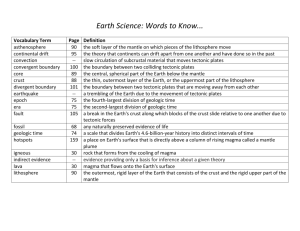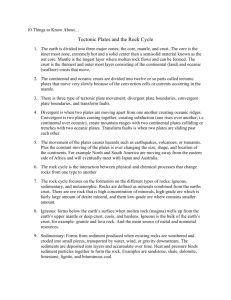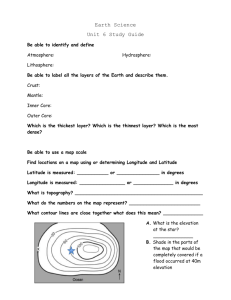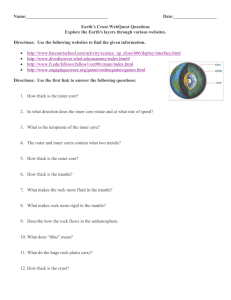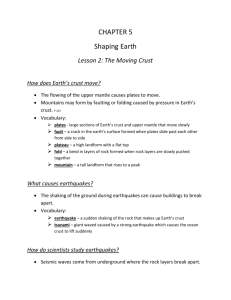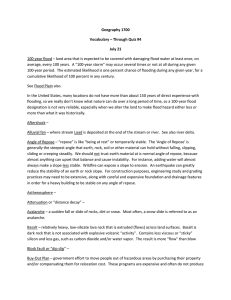Glossary for chapter 1,2,3
advertisement
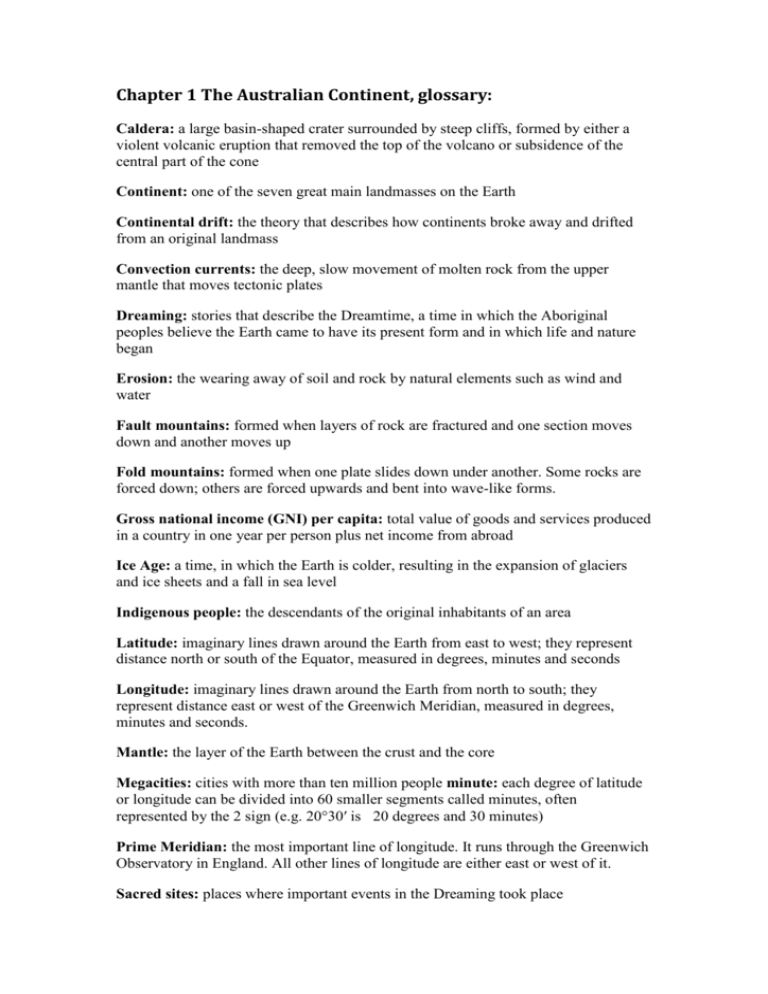
Chapter 1 The Australian Continent, glossary: Caldera: a large basin-shaped crater surrounded by steep cliffs, formed by either a violent volcanic eruption that removed the top of the volcano or subsidence of the central part of the cone Continent: one of the seven great main landmasses on the Earth Continental drift: the theory that describes how continents broke away and drifted from an original landmass Convection currents: the deep, slow movement of molten rock from the upper mantle that moves tectonic plates Dreaming: stories that describe the Dreamtime, a time in which the Aboriginal peoples believe the Earth came to have its present form and in which life and nature began Erosion: the wearing away of soil and rock by natural elements such as wind and water Fault mountains: formed when layers of rock are fractured and one section moves down and another moves up Fold mountains: formed when one plate slides down under another. Some rocks are forced down; others are forced upwards and bent into wave-like forms. Gross national income (GNI) per capita: total value of goods and services produced in a country in one year per person plus net income from abroad Ice Age: a time, in which the Earth is colder, resulting in the expansion of glaciers and ice sheets and a fall in sea level Indigenous people: the descendants of the original inhabitants of an area Latitude: imaginary lines drawn around the Earth from east to west; they represent distance north or south of the Equator, measured in degrees, minutes and seconds Longitude: imaginary lines drawn around the Earth from north to south; they represent distance east or west of the Greenwich Meridian, measured in degrees, minutes and seconds. Mantle: the layer of the Earth between the crust and the core Megacities: cities with more than ten million people minute: each degree of latitude or longitude can be divided into 60 smaller segments called minutes, often represented by the sign (e.g. 20°30′ is 20 degrees and 30 minutes) Prime Meridian: the most important line of longitude. It runs through the Greenwich Observatory in England. All other lines of longitude are either east or west of it. Sacred sites: places where important events in the Dreaming took place Sediment: material deposited by a stream or other body of water Tectonic plates: the various slow-moving plates that make up the Earth’s crust. Volcanoes and earthquakes often occur at the edges of plates. Tectonic processes: activities below the Earth’s surface that cause the breaking and bending of the Earth’s crust Time zones: the 24 zones of different time into which the Earth is divided Topography: physical features of an area of land — its height and shape Weathering: the breakdown of bare rock by water and temperature changes Chapter 2 Physical characteristics that make Australia unique, glossary: Climate: the long-term variation in the atmosphere, mainly relating to temperature and precipitation Deposition: the laying down of material carried by rivers, wind, ice, ocean currents or waves Drainage basin: the area of land that feeds a river with water or the whole area of land drained by a river and its tributaries Drought: a period of below average precipitation Ecosystem: a system formed by the interactions of the living organisms (plants, animals and humans) and physical elements of environments Endemic: native to a particular area and found nowhere else Erosion: the wearing away of soil and rock by natural elements such as wind and water Isobars: lines drawn on a map joining places of equal barometric pressure Marsupial: a mammal that keeps and feeds its young in a pouch for a few months after birth Mass movement: the movement of rock and soil down a slope due to gravity Monotreme: mammal that lays eggs; the only species are the platypus and echidna Monsoon: the seasonal change in wind direction that is experienced in much of the tropics Regolith: the layer of broken rock and soil on top of the solid rock of the Earth’s crust; also known as mantle rock Renewable resources: resources that can be replaced in a relatively short amount of time (for example, trees) Salinity: the presence of salt on the land surface, in soils or rocks, or dissolved in water in our rivers or ground water Species: a group of plants or animals of the same kind, able to breed with each other Synoptic chart: weather map that uses isobars and other symbols to show the movement of weather systems and patterns of temperature and rainfall tectonic: refers to the forces or conditions within the earth that cause movements of the crust such as earthquakes, folds, faults and volcanoes Topography: physical features of an area of land — its height and shape Unique: unlike anything else; the only one of its type Weathering: the breakdown of bare rock by water and temperature changes World Heritage List: areas designated as being of global importance for conservation and study Chapter 3 natural hazards in Australia, glossary: Alluvium: the loose material brought down by a river and deposited in its bed, flood plain or delta Bushfire: fire burning out of control in the open; also called a wildfire Cold front: boundary between warm air and advancing cold air Drought: a period of below average precipitation Earthquake: series of shock waves that are generated by a disturbance in the Earth’s crust El Niño event: the reversal (every few years) of the more usual direction of winds and surface currents across the Pacific Ocean. This change causes drought in Australia and heavy rain in South America. (Normally Australia has the rain and South America has the dry conditions.) Epicenter: the point on the Earth’s surface directly above the focus of an earthquake Fire front: the edge of the fire that spreads at the fastest rate Firebrand: aerial burning fuel that blows ahead of the fire front Firestorm: an intense fire, which may generate strong convection currents and violent winds that cause long- range spotting and flame spirals Flash flooding: sudden and destructive rush of water usually downhill following heavy rains on higher land Flood: an unusual accumulation of water that overflows from rivers, lakes or the ocean onto land that is not normally covered by water Flood mitigation: measures aimed at preparing for floods and trying to reduce their effects, such as constructing artificial levees, strengthening bridges, raising road levels and enlarging drains Flood plain: part of a river valley covered by water during floods Fuel: any material that burns Heat wave: a short period (usually a few days) of well above average temperatures La Niña event: a period of well above average rainfall in eastern Australia, which often brings floods Natural disaster: occurs as a result of a hazardous natural event that dramatically affects a community Natural hazard: a natural event or object that is a potential source of harm to a community Richter scale: used to measure the energy of earthquakes Sclerophyll: plants found in low rainfall areas; their leathery leaves help reduce water loss Southern Oscillation: a major air pressure shift between the Asian and east Pacific regions. Its most commonly known extremes are those referred to as El Niño events. Stubble: the stumps or stalks left in the ground when a crop, such as wheat, is harvested Subsidy: direct financial aid given by a government to an individual or group to reduce the price of a good or service Tropical cyclone: severe weather event that occurs when warm, moist rising air begins to spiral upwards. Very strong winds, heavy rain and rough seas often accompany tropical cyclones.



